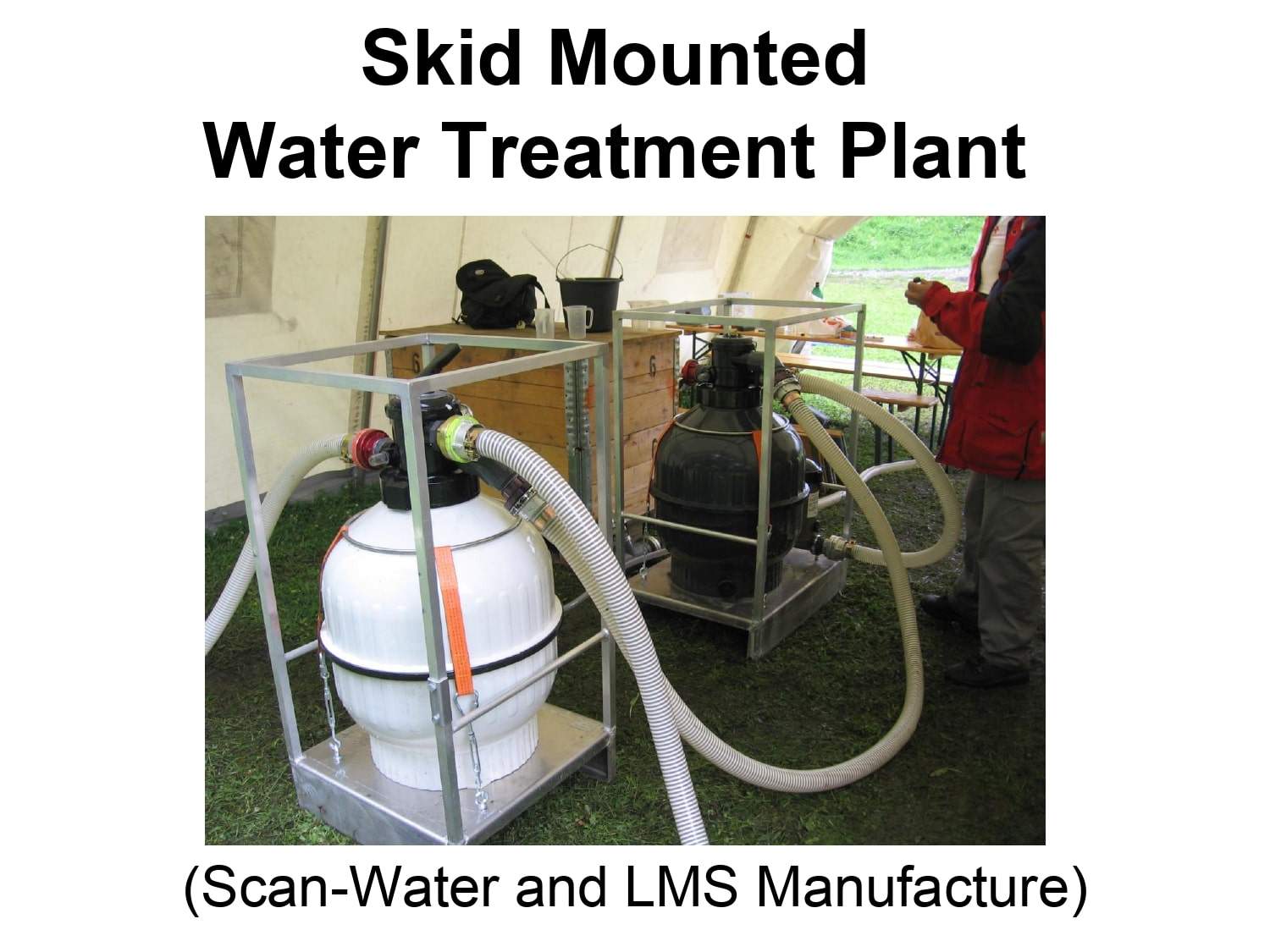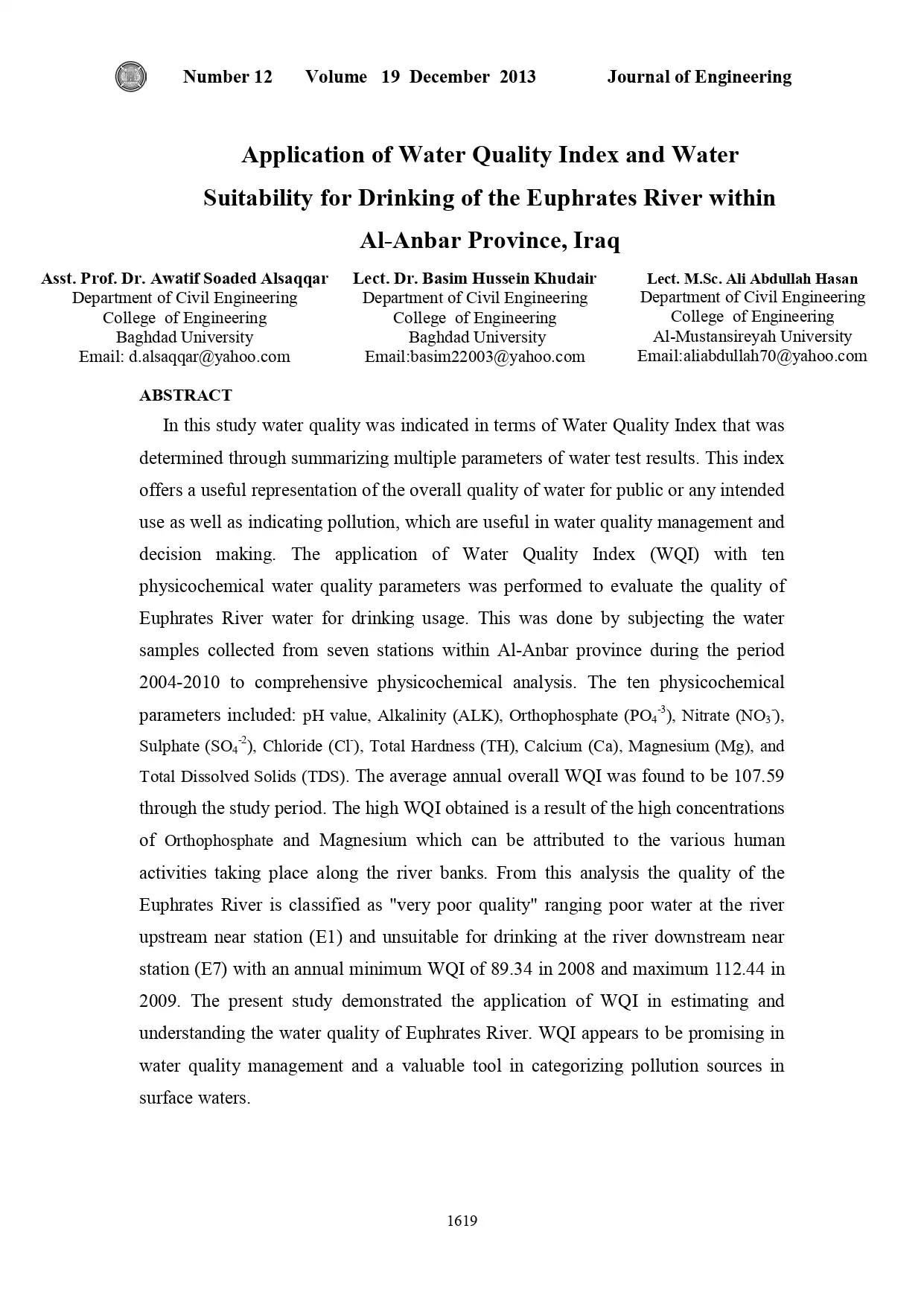Skid Mounted Water Treatment Plant
Usually dispatched in 2 to 3 days
Usually dispatched in 2 to 3 days
Category:
Drinking Water Treatment
Only logged in customers who have purchased this product may leave a review.
Related products
Application of Water Quality Index and Water Suitability for Drinking of the Euphrates River within Al-Anbar Province, Iraq
In this study water quality was indicated in terms of Water Quality Index that was determined through summarizing multiple parameters of water test results. This index offers a useful representation of the overall quality of water for public or any intended use as well as indicating pollution, which are useful in water quality management and decision making. The application of Water Quality Index (WQI) with ten physicochemical water quality parameters was performed to evaluate the quality of Euphrates River water for drinking usage. This was done by subjecting the water samples collected from seven stations within Al-Anbar province during the period 2004-2010 to comprehensive physicochemical analysis.
Application of Water Quality Index and Water Suitability for Drinking of the Euphrates River within Al-Anbar Province, Iraq
In this study water quality was indicated in terms of Water Quality Index that was determined through summarizing multiple parameters of water test results. This index offers a useful representation of the overall quality of water for public or any intended use as well as indicating pollution, which are useful in water quality management and decision making. The application of Water Quality Index (WQI) with ten physicochemical water quality parameters was performed to evaluate the quality of Euphrates River water for drinking usage. This was done by subjecting the water samples collected from seven stations within Al-Anbar province during the period 2004-2010 to comprehensive physicochemical analysis.
Introduction to Water Treatment
This is an introduction to water treatment systems and technology. It is not a design manual or an exhaustive treatise. It is intended for engineers who are not regularly involved in water treatment projects, but who are interested in learning some of the basics involved. Criteria to be followed in determining the necessity for and the extent of treatment are discussed here, as are procedures applicable to the planning of water treatment projects.
Introduction to Water Treatment
This is an introduction to water treatment systems and technology. It is not a design manual or an exhaustive treatise. It is intended for engineers who are not regularly involved in water treatment projects, but who are interested in learning some of the basics involved. Criteria to be followed in determining the necessity for and the extent of treatment are discussed here, as are procedures applicable to the planning of water treatment projects.
Analysis of the Membrane Alternatives Suitable for Kvarnagården Water Treatment Plant.
In this study surveys to membrane manufacturers and water treatment plants regarding the performance of different membrane alternatives have been carried out from January to April 2012. The work has been done as a part of a study of the different membrane alternatives suitable for Kvarnagården Water Treatment Plant. Also in the study experiments regarding water quality parameters have been carried out at the water laboratory at Chalmers University of Technology. The project is carried out at the Department of Civil and Environmental Engineering and is connected to the company VIVAB, the company in charge of Kvarnagården Water Treatment Plant.
Analysis of the Membrane Alternatives Suitable for Kvarnagården Water Treatment Plant.
In this study surveys to membrane manufacturers and water treatment plants regarding the performance of different membrane alternatives have been carried out from January to April 2012. The work has been done as a part of a study of the different membrane alternatives suitable for Kvarnagården Water Treatment Plant. Also in the study experiments regarding water quality parameters have been carried out at the water laboratory at Chalmers University of Technology. The project is carried out at the Department of Civil and Environmental Engineering and is connected to the company VIVAB, the company in charge of Kvarnagården Water Treatment Plant.
Inorganic Contaminant Removal
The 2006 version of the Pa. DEP Inorganic Contaminant Removal module has detailed advanced treatment information on this topic and can be obtained by e-mailing the Pa. DEP Safe Drinking Water Training Section at DEPWSTechtrain@pa.gov to request a copy. This advanced module has additional information on the removal of various inorganic contaminants as well as on oxidation, ion exchange, activated alumina and sequestration. The 2006 document also includes more detailed information on the inorganic contaminant treatments of GAC (granular activated carbon), coagulation/filtration, membranes, and lime softening. It includes the following information:
- Inorganic contaminant treatment selection considerations
- Advanced inorganic contaminant removal chemistry terminology
- Advanced inorganic contaminant removal chemistry explanations
- Conventional filtration and how it relates to inorganic removal
- Detailed information on treatments for iron and manganese removal
- Detailed information on treatments for hardness removal
- Detailed information on inorganic contaminant monitoring protocols
- Detailed tables on the following topics:
- Sources of 26 inorganic contaminants
- Common secondary standards with effects, inorganic contributors and indications
- Various treatment technology options to consider for 24 inorganic contaminants
- Potential forms of iron and manganese
- Iron and manganese sampling procedures
- Iron and manganese oxidant selection criteria
- Iron and manganese theoretical (initial) dosing criteria
- Potential treatments for less common inorganics
- Potential treatments for miscellaneous trace metals
Inorganic Contaminant Removal
The 2006 version of the Pa. DEP Inorganic Contaminant Removal module has detailed advanced treatment information on this topic and can be obtained by e-mailing the Pa. DEP Safe Drinking Water Training Section at DEPWSTechtrain@pa.gov to request a copy. This advanced module has additional information on the removal of various inorganic contaminants as well as on oxidation, ion exchange, activated alumina and sequestration. The 2006 document also includes more detailed information on the inorganic contaminant treatments of GAC (granular activated carbon), coagulation/filtration, membranes, and lime softening. It includes the following information:
- Inorganic contaminant treatment selection considerations
- Advanced inorganic contaminant removal chemistry terminology
- Advanced inorganic contaminant removal chemistry explanations
- Conventional filtration and how it relates to inorganic removal
- Detailed information on treatments for iron and manganese removal
- Detailed information on treatments for hardness removal
- Detailed information on inorganic contaminant monitoring protocols
- Detailed tables on the following topics:
- Sources of 26 inorganic contaminants
- Common secondary standards with effects, inorganic contributors and indications
- Various treatment technology options to consider for 24 inorganic contaminants
- Potential forms of iron and manganese
- Iron and manganese sampling procedures
- Iron and manganese oxidant selection criteria
- Iron and manganese theoretical (initial) dosing criteria
- Potential treatments for less common inorganics
- Potential treatments for miscellaneous trace metals
Removal of Aluminium from Drinking Water
Aluminium in drinking water comes from natural sources and the alum used as coagulant in the water treatment process. Exposure to aluminium has been implicated in dialysis dementia, Parkinson and Alzheimer’s disease. Drinking water containing aluminium was considered to be one of the main sources of Al intake into human body. For this reason, the removal of aluminium from drinking water is vital to our health. In this study, removal of aluminium was carried out by using a chelating resin.
Removal of Aluminium from Drinking Water
Aluminium in drinking water comes from natural sources and the alum used as coagulant in the water treatment process. Exposure to aluminium has been implicated in dialysis dementia, Parkinson and Alzheimer’s disease. Drinking water containing aluminium was considered to be one of the main sources of Al intake into human body. For this reason, the removal of aluminium from drinking water is vital to our health. In this study, removal of aluminium was carried out by using a chelating resin.
Module 11: Administration of Water Treatment Plants
• Describe how water treatment plants comply with their minimum federal and state monitoring requirements.
• List the three ways in which management ensures that the staff complies with monitoring requirements.
• Discuss reporting requirements when complying with federal and state regulations.
Module 11: Administration of Water Treatment Plants
• Describe how water treatment plants comply with their minimum federal and state monitoring requirements.
• List the three ways in which management ensures that the staff complies with monitoring requirements.
• Discuss reporting requirements when complying with federal and state regulations.
Biofilm Control Study
Darigold operates a milk products facility in Lynden, Washington. Production processes include evaporation of milk, which generates what is referred to as condensate of whey (COW) water. COW water contains low molecular weight organic compounds including traces of lactic acid, alcohols, acetoin, and non-protein nitrogen (Möslang, 2017). COW water and non-contact cooling water from the Darigold Lynden facility are currently discharged to Outfall 001, which combines with stormwater and the City of Lynden’s wastewater treatment plant (WWTP) effluent discharge to the Nooksack River through the City’s outfall. Darigold’s discharge is regulated under National Pollutant Discharge Elimination System (NPDES) Permit No. WA0002470 administered by the Washington Department of Ecology (Ecology). In the future, Darigold’s COW Water and non-contact cooling water will be directly discharged to the Nooksack River in a new outfall pipe (Outfall 002) currently being constructed by the City.
Biofilm Control Study
Darigold operates a milk products facility in Lynden, Washington. Production processes include evaporation of milk, which generates what is referred to as condensate of whey (COW) water. COW water contains low molecular weight organic compounds including traces of lactic acid, alcohols, acetoin, and non-protein nitrogen (Möslang, 2017). COW water and non-contact cooling water from the Darigold Lynden facility are currently discharged to Outfall 001, which combines with stormwater and the City of Lynden’s wastewater treatment plant (WWTP) effluent discharge to the Nooksack River through the City’s outfall. Darigold’s discharge is regulated under National Pollutant Discharge Elimination System (NPDES) Permit No. WA0002470 administered by the Washington Department of Ecology (Ecology). In the future, Darigold’s COW Water and non-contact cooling water will be directly discharged to the Nooksack River in a new outfall pipe (Outfall 002) currently being constructed by the City.
Big Data Analysis For Studying Water Supply And Sanitation Coverage In Cities (Russia)
Big data analysis for water supply and sanitation is important for ensuring urban viability. Our research is devoted to studying the methodology for analyzing big data of the water supply and sanitation systems. Based on a review of scientific publications and their analysis, a model for analyzing large data was proposed. It comprises information sources, data collection and storage platforms with indication of parameters for the programming model, runtime and
storage environment, as well as data analysis and processing.
Big Data Analysis For Studying Water Supply And Sanitation Coverage In Cities (Russia)
Big data analysis for water supply and sanitation is important for ensuring urban viability. Our research is devoted to studying the methodology for analyzing big data of the water supply and sanitation systems. Based on a review of scientific publications and their analysis, a model for analyzing large data was proposed. It comprises information sources, data collection and storage platforms with indication of parameters for the programming model, runtime and
storage environment, as well as data analysis and processing.















Reviews
There are no reviews yet.